

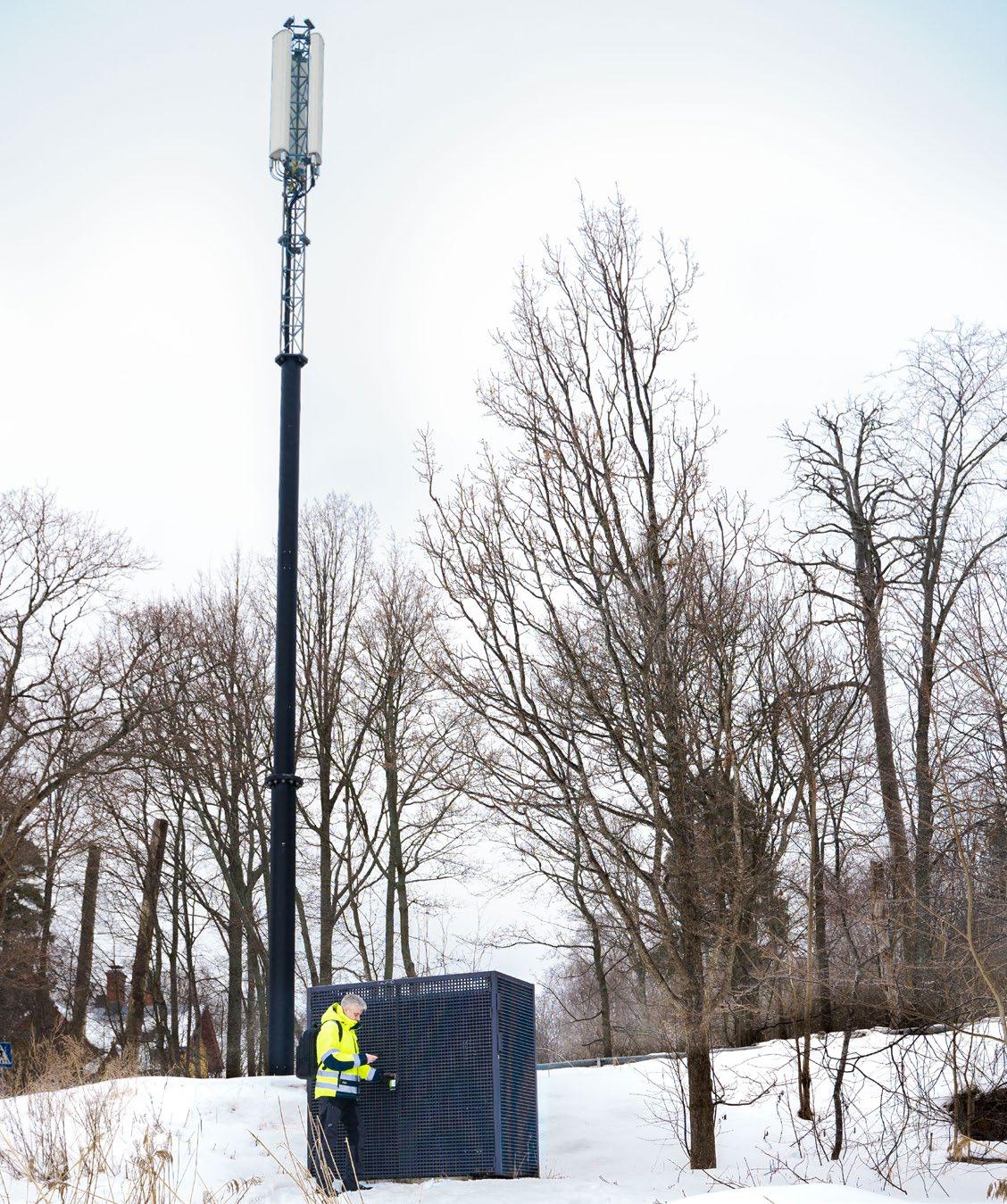
“Mobile credentials have the power to revolutionise access control - making it more sustainable, convenient and flexible.”
Steve Wintle, Head of Critical Infrastructure at ABLOY








“Mobile credentials have the power to revolutionise access control - making it more sustainable, convenient and flexible.”
Steve Wintle, Head of Critical Infrastructure at ABLOY




The world is adopting new technologies at an astounding rate, and as a society we are becoming more reliant on digital devices. When it comes to managing access control, mobile credentials are gaining popularity across a wide range of industries and applications.
Sophisticated digital devices are indispensable tools for professionals in many industries. Many of these devices now carry mobile credentials to manage access control. A mobile credential is a digital access key that sits on a smart device such as a smartphone. This replaces traditional credentials such as a key, a fob, or a card. A mobile credential allows you to authenticate with your smartphone and use it as your key to gain access to a building, room, or remote location.
In this white paper, we explore the reasons why mobile credentials are in greater demand. Reasons like the desire for flexibility and convenience, the opportunity for ease in managing access rights with instant delivery, and the need for increased security and sustainability. We will consider barriers to the implementation of mobile credentials and recommend the type of applications where they could be the most appropriate access solution. Finally, we will introduce access control systems that incorporate both keyed and keyless solutions, allowing organizations to choose what works best at each access point.
The global mobile workforce - a group of employees not bound by a central physical location but connected by various types of mobile technology - is expected to reach 1.87 billion workers by 2022¹. This new way of working brings a requirement for adaptable and flexible access control.
Mobile credentials offer convenience, as it replaces the need for a separate RFID credential when you can open secure doors and openings with a device you already carry. For example, a smartphone can raise parking lot barriers, access the printer network, or open a locker.
They are also flexible, as Security or HR managers can amend, issue or cancel credentials from anywhere, and building users always have their access rights up to date. Plus, as mobile credentials are updated wirelessly and remotely over the air, it reduces the need for in-person contact to hand over keys, cards, or fobs. This improves efficiency, as employees waste less time collecting or amending access credentials in person and visitors get instant temporary access when they need it.
Mobile credentials also reduce the risk of employees or contractors traveling to a destination and then discovering they can’t access it. Research² finds that over twothirds of organizations will have adopted mobile access control to some extent within two years. This increase in adoption has been accelerated by the impact of the pandemic and the growth in working from home.
“A mobile workforce is a group of employees that isn’t bound by a central physical location. Instead, the employees are connected by various types of mobile technology: computers, smartphones and other mobile devices.” Global mobile workforce is expected to reach of
workers by 2022
access control within two years
1.87 billion Two-thirds
Relying on passwords without any other security measure is no longer acceptable in the cyber world, as they can be shared, stolen and copied. The only way to overcome this issue is to verify the identity of the individual attempting to gain access. Identity verification has become standard practice in society, such as when shopping or banking online.
Mobile credentials utilize on-device passwords and biometrics such as fingerprint, voice, and facial recognition to keep unauthorized people or groups from accessing the key stored on the smartphone. This is seen as a significant advantage over a physical key, fob, or card credential.

Keys, cards and fobs are easily lost by users. If a key or fob goes missing, it can be used by any person that has it in their possession. Mobile credentials are seen as a more secure way to manage access, as people are less likely to lose a mobile phone. In the uncommon circumstance that a mobile phone is lost, the level of security on the device means that it will be incredibly difficult for someone to utilize the mobile credential.
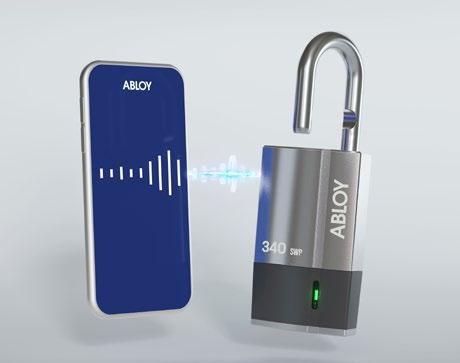
People will notice more quickly if they have lost a mobile than if they misplace a key or fob. This means the organization can be quickly alerted to the missing smartphone, so they can revoke access instantly using the credential’s management software.
When using traditional credentials such as a key, card or fob, there is a time and efficiency cost in distribution, whether that is via delivery or handing them out physically. Mobile keys offer a more flexible and convenient solution, as Security and Operations managers can amend, issue or cancel credentials from anywhere and building users always have their access rights up to date.

Plus, as mobile credentials are updated wirelessly and remotely, it reduces face-toface contact for both staff and visitors, which is seen as another benefit in the wake of the pandemic. It’s a more efficient system, and employees waste less time collecting or amending access credentials in person and visitors get instant temporary access when they need it.
Eliminating the need for key cards and fobs – and the constant replacement of lost cards and fobs - reduces plastic usage too. For organizations with contractors travelling between disparate and remote sites, mobile credentials offer a way to enable access permission changes in real time. This not only reduces CO² emissions from wasted trips where an incorrect key may have been provided, as well as going back and forth to collect and return keys, but improves operational efficiencies, and creates a more flexible workforce, saving time and money, while improving management and tracking of who accessed what and when.
With all the advantages of mobile credentials, it’s easy to forget there is still a need to manage mobile keys. Mobile credentials can be convenient and flexible, and in some cases practical for external applications, but it’s not the credential that’s providing the actual security.
The credential provides confirmation that the holder is authorized to access a site or open a lock - and that’s where the practicality issues come into question.
The credential is seen as the answer to no physical keys, which has been a challenge for most businesses to manage. The reality
is, a mobile credential still needs to be managed, and this is a factor that needs to be planned in.
Without question, integration of mobile technologies with Permit to Work ticketing and individuals’ training and competencies records can make the management of access control easier, and at the same time enforce compliance. Automation will allow the process to happen routinely, providing a seamless and efficient operation, while also enabling the exceptions to be scrutinized. But beyond the credential, the flexibility in what it could operate and how it can be used is often underestimated.
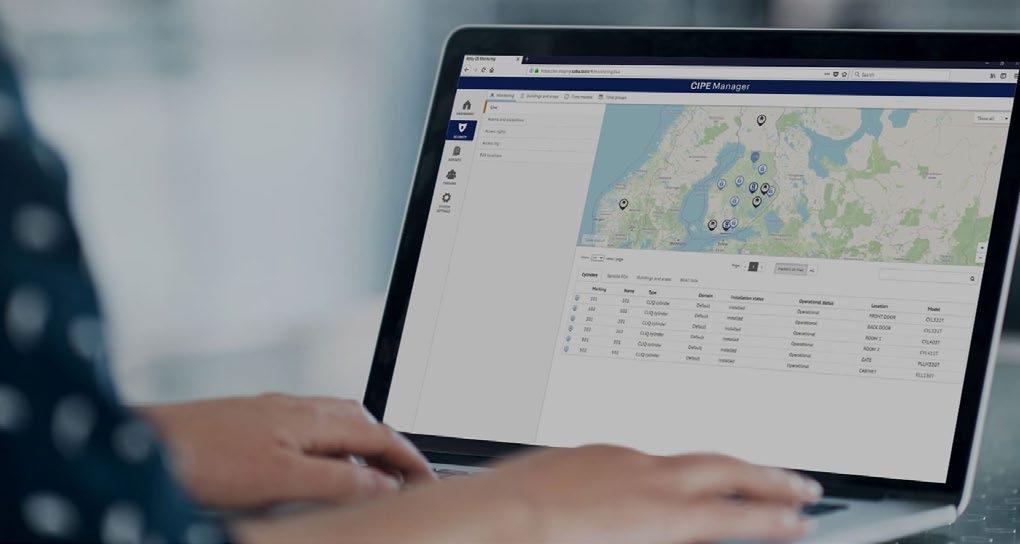
The increased usage of mobile credentials has not come without concerns and criticisms. Mobile credentials require a lock that has an inbuilt reader, a power source, and a mechanism to turn the lock. At present, a large thumb turn is usually provided on the outside, acting as the reader and the mechanism for operating the lock. This design leaves the lock vulnerable for a vandal or thief to attack and disable, causing disruption and potential easy access for the perpetrator.
This in turn causes an issue for the authorized engineer or contractor needing to gain access. If it’s a high-security door, then how do you protect the thumb turn with a high-security shroud against hammer or drilling attack? In this instance, a physical key is a more practical means of securing and controlling access to critical assets. Phone battery life was also listed as a
potential issue. A phone with no battery charge means no access can be granted to the user, which can impact a business in terms of lost working hours. This is where unpowered fobs, cards, and physical keys are seen as a more reliable source of credentials.
Keys are still a very practical solution in some circumstances, especially for legacy estates with traditional locking mechanisms. There will also be certain environments where mobile phone usage is simply not permitted – nuclear sites, for example - making mobile credentials an unsuitable solution.
Fortunately, ABLOY’s digital portfolio includes both keyless and keyed locking solutions, which means the right solution can be used at every access point and stay in the same system.
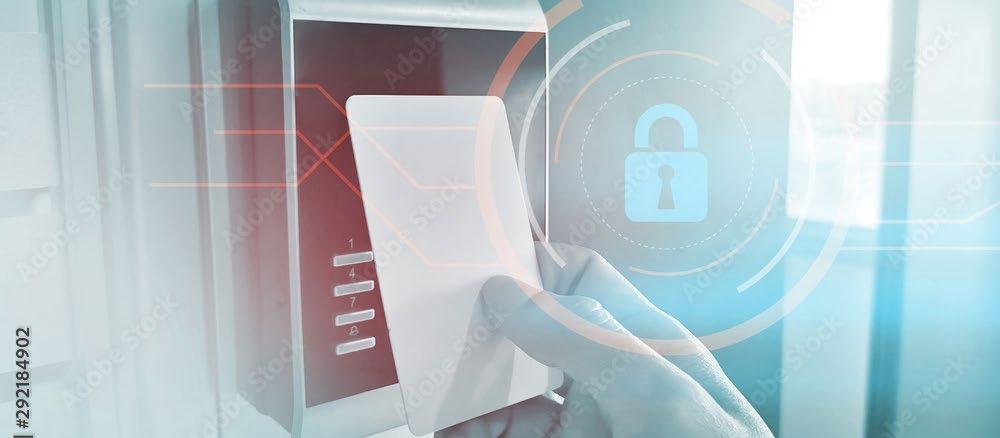
ABLOY’s CIPE Manager connects with every locking solution in ABLOY’s digital portfolio, including keyless BEAT Bluetooth padlocks, the electromechanical PROTEC2 CLIQ® system, and ABLOY’s high-security mechanical master key systems. This range of traditional and digital access solutions can be combined in a variety of ways to meet virtually any requirements, providing flexible, scalable, and compliant security, while helping to control the movement of people in a wide range of industries, building types, and applications.
CIPE Manager has been designed specifically for day-to-day operational use by security, operations, and facility management to control keys and manage access rights to their organizations’ critical infrastructure sites and facilities. Typical sectors include energy, water, telecom, oil, gas, rail, ports, and airports.
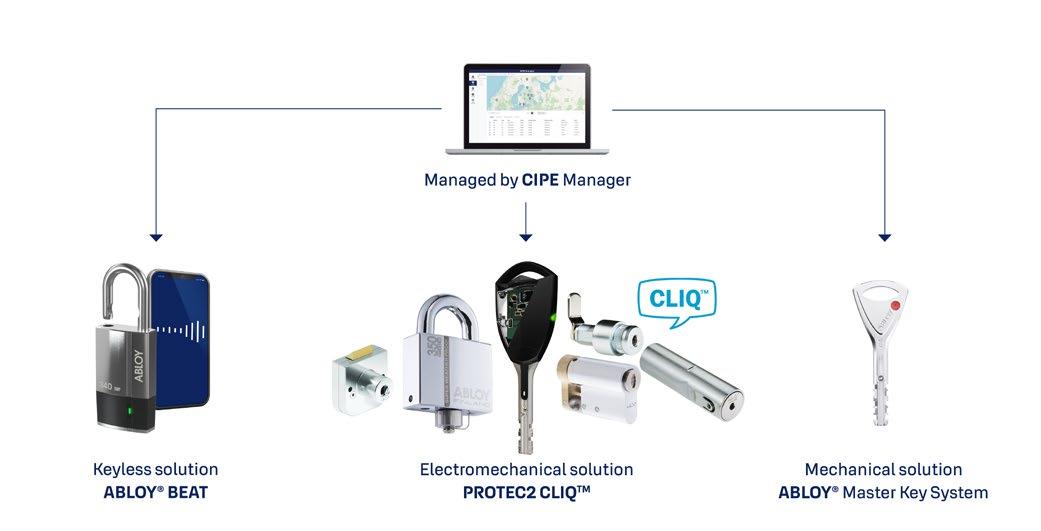
CIPE Manager is tailored to give a comprehensive situational overview and increase operational efficiency in critical infrastructure access management and key control. The solution allows organizations to easily manage all their keys, locks, and access rights from any location, with a userfriendly, cloud-based management system. It includes a highly visual map-based user interface that provides a clear overview of the variety of locking points.
The user interface is browser-based, allowing the management of keys, locks, and access rights remotely from any location with most mobile devices or desktop computers. The administrator using CIPE Manager can grant and revoke access permissions to people according to their roles, e.g. job tasks or organization. In addition to easy access management, the solution offers extended reporting and tracking features with full audit trail data.
BEAT is a new keyless padlock that combines three main components: a digital key, a mobile application, and a heavy-duty, Bluetooth padlock, all managed with the visual CIPE Manager user interface. BEAT is IP68-rated and is designed specifically for the physical protection of critical infrastructure, businesses, and remote sites. BEAT physically secures property while offering customers improved operational efficiency, reducing both logistics and costs. Setting a benchmark in keyless solutions and heralding a new era of effortless mobile connectivity, the BEAT Bluetooth padlock utilizes Seos® credential technology for best-in-class security and privacy protection.
Made to perform at all times in the most demanding environments, the BEAT smart padlock is functional both online and offline, and allows flexible access and activation
of user rights from wherever you are via the mobile app. BEAT is especially useful in remote areas, with busy schedules and in case of emergency, as travel and key logistics are drastically simplified, saving on emissions, time, and cost. This is ideal for the ad hoc visitor needing to access it once, rather than on a regular basis.
Integration with ABLOY CIPE enables the remote management of keys, locks, and access rights from a single, highly visual, and easy-to-use interface. The BEAT highsecurity padlock can also be integrated with third-party systems or added to your existing workflow. BEAT adds operational excellence to any critical infrastructure organization, in a wide range of sectors. It is always in sync with your security situation, keeping a smooth flow of all contractors and employees, while tracking every movement.
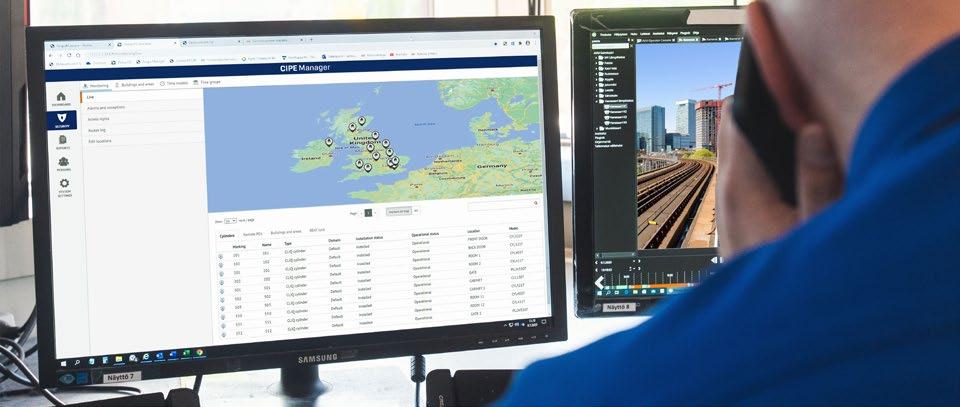
PROTEC2 CLIQ® is an innovative easy-touse electrochemical locking system that can be integrated with the CIPE Manager. It enables remote key management and provides comprehensive audit trails on locks and padlocks. PROTEC2 CLIQ® is trusted by many critical infrastructure organizations across the globe and fulfills the requirements of regulators. The risk of lost or stolen keys is eliminated as they can quickly be removed from the system. CLIQ® combines programmable physical keys and a range of wireless locks and padlocks with user-friendly admin software. This solution improves the site and building security and offers flexible access rights and key management, which can be controlled anytime and from anywhere.
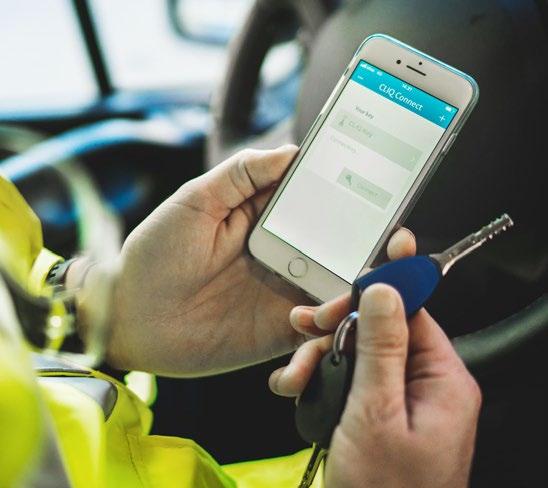

It’s clear to see why mobile credentials are gaining in popularity, and while there is certainly an increasing demand for this kind of technology, there will remain a requirement for keyed solutions in certain environments. By choosing a solution such as CIPE Manager, organizations can get the best of both worlds and adapt their credentials for different applications to meet their requirements. This offers the ability to have a mix of physical keys, cylinders and padlocks, as well as digital technology using mobile credentials where it is the best solution, all integrated into one platform for convenient, controlled and secure access management.


Abloy is a security and locking innovation company with trust at the core of all our activities. By combining mechanical and digital expertise Abloy develops modern, industry leading security solutions to protect people, property and business. Abloy is part of the ASSA ABLOY Group
Abloy USA Critical Infrastructure
6005 Commerce Drive #330 Irving, TX 75063
Tel. 972.753.1127 800.367.4598
info@abloyusa.com www.abloyusa.com
